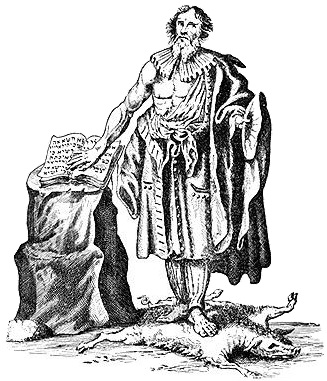
The oath More Judaico or Jewish Oath was a special form of oath that Jews were forced to take when they testified in a Christian or Muslim court. More Judaico (latin for "on/by the Jewish custom") was imposed following rumors about the trustworthiness of the Jewish Oath connected with the meaning that Christian authorities assigned to the Kol Nidre prayer. The non-Jews argued that since a Jew has ways to annul the vow, one must doubt his obligation to speak truthfully under oath or to do the things he swore to do.
The oath was first introduced in the Byzantine Empire during Justinian's reign in 531. The Byzantine emperors who came after Justinian established a ceremony with humiliating symbols in which the Jew had to surround himself with thorns, hold the Torah scroll and swear that if he was not speaking the truth he would be punished and the earth would open and swallow him up like Datan and Aviram. At the end of the 8th century, during the reign of Charlemagne, curses and threats were added to the Byzantine version, and in a French law book it was determined that the swearing Jew must wear a wreath of thorns around his neck, stand with his knees tied and a branch of thorns between his calves. According to another version, the Jew was forced to stand barefoot on the bleeding skin of a calf or sheep and point with his right hand on an open Torah scroll.
In the Moldovan principality, the oath was established during the reign of Grigore Ghica, who ruled from 1739 to 1741. There was another version written in 1786, copied in 1828, during the reign of Ion Sandu Sturdza, implemented in Iasi and other cities in Moldova. Before the oath was taken, the Jew had to fast, immerse himself in the mikveh (ritual bath), wear the shroud of the dead and attend synagogue on a Monday or Thursday, when there was a reading from the Torah. There he had to wrap himself in a prayer shawl, put on tefillin and lie on a death bed. Above his head they held a candle and the rabbi blew the shofar seven times while reciting curses and punishments. The sworn was to repeat after the rabbi and lay his hand on the Torah. The judge or his replacement threatened the sworn that if he lied, he would be punished and the earth would open its mouth and swallow him, his family and his property.
In the principality of Wallachia, the oath was conducted from the year 1800 onwards, and some additional details were added to the humiliating ceremony: the death bed was covered with black cloth and two black candles were placed next to it. The sworn stood barefoot in the presence of a number of prominent Jews in the city, reading the oath while holding the Torah scroll and touching the death bed.
After the French Revolution, all over the world there was a struggle to cancel the humiliating oath of the Jews. In France, Adolphe Cremieux defended the young rabbi Isidor Lazar, who in 1838 refused to open the synagogue for the oath, and on March 3, 1846 the French Supreme Court ruled that the oath was against the constitution.
In Romania, too, rabbis opposed the Jewish oath and refused to participate in the ceremony or locked synagogues in order to prevent the humiliating ceremony, including the Sephardic Chief Rabbi of Bucharest, Chaim Bejerano, Rabbi Israel Margulies of Brăila and others. There were also rabbis and public figures who struggled to cancel the oath, including Rabbi Yaakov Niemerover, Rabbi Yitzhak Taubes of Bârlad and Dr. Yaakov Nacht of Focşani, who wrote comparative studies on the oath and sent petitions to the authorities. The struggle bore fruit in 1912, when the oath was officially canceled in Romania.